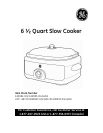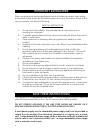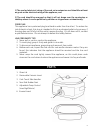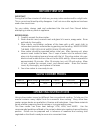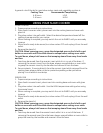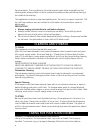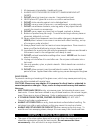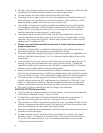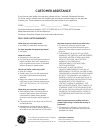8
• Stirring is not necessary when slow cooking. However, if cooking on HIGH, stirring
occasionally will help to distribute flavors throughout the recipe.
• For best results, the slow cooker should be at least half-filled.
• If cooking soups or stews, allow a 2-inch space between the food and the top of
the cooking pot, so ingredients can come to a simmer. When cooking on HIGH,
keep checking progress, as some soups may come to boil.
• Less tender, cheaper cuts of meat are better candidates for slow cooking than
more expensive varieties. When possible, remove excess fat before cooking. If
recipe calls for browning the meat, brown it on a range top using a separate
cooking utensil before placing meat in cooking pot.
• The greater the fat content of the meat, the less liquid needed for cooking. If
cooking meat with a high fat content, place thick onion slices beneath it, so the
meat will not sit and cook in the fat. Roasts may be prepared in cooker without
adding liquid, if cooked on LOW.
• Always use a meat thermometer to determine if meats have been cooked to
proper temperature.
• Add fresh or thawed fish or seafood to cooking pot an hour before serving, as
these ingredients can fall apart during long hours of cooking.
• Since raw vegetables usually take longer to cook than meats, cut vegetables into
uniform, bite-sized pieces (about ½ inch in diameter) before adding them to the
cooking pot.
• If recipe calls for milk, sour cream or other fresh dairy products, add just prior to
serving, as they tend to break down over long hours of cooking. If preferred,
substitute condensed creamed soups (undiluted) or evaporated milk. Processed
cheese may be substituted for naturally aged cheese.
• Rice or pasta may be cooked separately or added uncooked to recipes no more
than two hours before serving. If adding uncooked pasta, there should be at least
2 cups of liquid in the pot. Stir occasionally to keep pieces from sticking together.
• To thicken juices or making gravy at the end of the cooking process, make a
smooth mixture consisting of 2-4 tablespoons or cornstarch or flour and ¼ cup
water or 2 tablespoons of butter. Remove cooked food from pot, letting juices
remain. Add mixture to juices, set control at HIGH, and stir until liquid thickens.
• Don’t worry if food is allowed to cook a bit longer than specified.
ADAPTING RECIPES (General Hints)
• The LOW setting is recommended for all-day cooking. Most meat-and-vegetable
combinations required at least 7 hours on LOW.
• For best flavor, use whole-leaf herbs and spices during initial preparation. If
ground herbs and spices are used, stir in during last hour of cooking.
• Many factors can affect how quickly a recipe will cook. The water and fat content
of food, its temperature, and the size of the item(s) will all affect the cooking time.
Food cut into pieces will cook faster than larger pieces.
• Recipes for vegetable-type casseroles must contain liquid to prevent scorching on
the sides of the cooking pot.
• If using a specific recipe, one item may be substituted for another, if an equal
quantity is used. For example, if recipe calls for a 12-oz. can of chicken broth, a
10-oz. can of tomato soup plus 2 oz. of something else (water, wine, canned
tomatoes) may be substituted.



